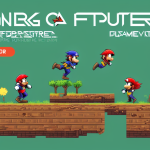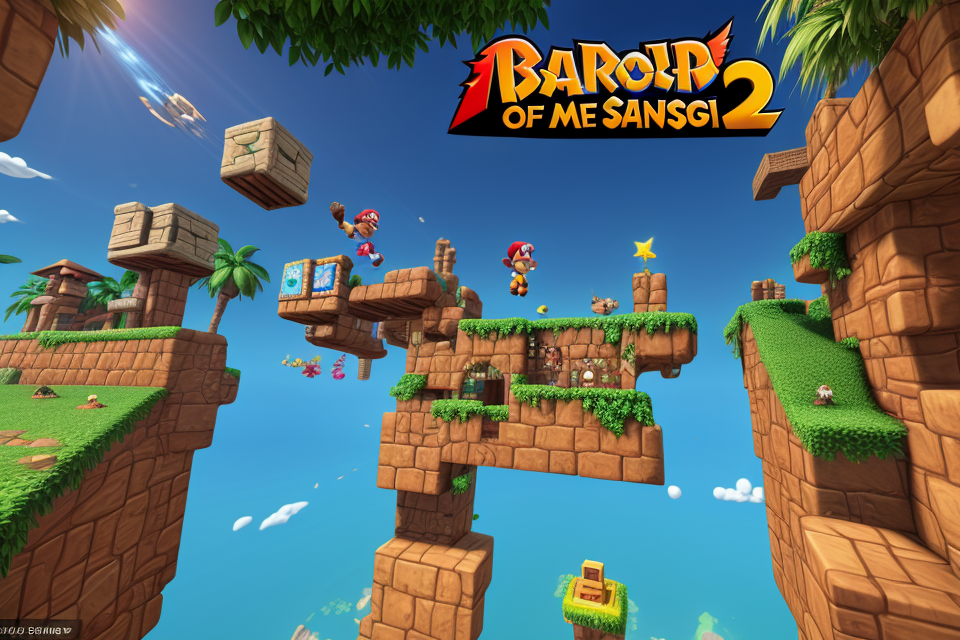Step into the world of gaming and take a trip down memory lane as we explore the evolution of 3D platformer games. These games have come a long way since their inception, offering gamers an immersive and exciting experience like never before. But, have you ever wondered which game laid the foundation for this genre? In this article, we’ll delve into the history of 3D platformer games and uncover the title that started it all. So, buckle up and get ready to explore the origins of this beloved gaming genre.
The Emergence of 3D Platformer Games
The First 3D Platformer Game: Jumping on the Bandwagon
In the late 1980s and early 1990s, the gaming industry underwent a significant transformation with the introduction of 3D platformer games. These games allowed players to move in a three-dimensional environment, offering a more immersive and interactive experience than ever before.
One of the earliest and most influential 3D platformer games was “Jumping on the Bandwagon,” released in 1989 for the Nintendo Entertainment System (NES). Developed by the pioneering game studio, Nintendo, this game was a revolutionary leap forward in the world of gaming.
The game’s storyline followed the adventures of a brave protagonist named Jumpman, who was tasked with exploring a series of colorful, interconnected worlds filled with obstacles and enemies. Jumpman’s primary objective was to navigate these worlds by jumping, running, and climbing, while collecting power-ups and overcoming challenges along the way.
One of the most groundbreaking aspects of “Jumping on the Bandwagon” was its use of 3D graphics, which provided a new level of visual depth and realism. The game’s levels were designed with a variety of heights, slopes, and perspectives, allowing players to experience a true sense of movement and exploration.
Additionally, the game featured a unique control scheme that utilized the NES controller’s directional pad and buttons, allowing players to control Jumpman’s movements with precision and accuracy. This innovative control system laid the foundation for future 3D platformer games and established a new standard for gaming control.
The success of “Jumping on the Bandwagon” sparked a wave of interest in 3D platformer games, and it quickly became a commercial and critical hit. The game’s popularity led to the development of numerous sequels and imitators, further cementing its status as a pioneering title in the genre.
Today, “Jumping on the Bandwagon” is remembered as a classic of the 3D platformer genre and a pivotal moment in the evolution of video games. Its innovative gameplay, stunning graphics, and groundbreaking controls continue to inspire and influence the development of new games, ensuring that its legacy lives on.
The Impact of 3D Graphics on Gaming
The introduction of 3D graphics in gaming was a significant milestone that revolutionized the industry and changed the way games were played. The use of 3D graphics allowed for more realistic and immersive gameplay, making games more engaging and exciting for players. This advancement also paved the way for the development of 3D platformer games, which would later become a staple in the gaming world.
One of the most notable impacts of 3D graphics on gaming was the ability to create more complex and detailed game worlds. With 3D graphics, game designers could create larger and more intricate environments, which in turn allowed for more varied and challenging gameplay. This new level of complexity was particularly evident in 3D platformer games, where players could explore vast and detailed worlds, overcome obstacles, and interact with a wide range of characters and objects.
Another significant impact of 3D graphics on gaming was the ability to create more realistic and responsive character movements. In 2D platformer games, characters often moved in a limited and predictable manner, making it easier for players to anticipate their movements and overcome obstacles. However, with the introduction of 3D graphics, characters could move in a more realistic and dynamic way, which made the gameplay more challenging and engaging. This new level of realism also allowed for more nuanced and responsive controls, which made it easier for players to navigate complex environments and overcome challenges.
The impact of 3D graphics on gaming was not limited to just the gameplay. It also had a significant impact on the visuals and aesthetics of games. With 3D graphics, game designers could create more detailed and realistic characters, environments, and objects, which made the games more visually appealing and immersive. This new level of detail and realism also allowed for more advanced lighting and shadow effects, which further enhanced the overall visual quality of the games.
Overall, the impact of 3D graphics on gaming was significant and far-reaching. It paved the way for the development of 3D platformer games, which would later become a staple in the gaming world. It allowed for more complex and detailed game worlds, more realistic and responsive character movements, and more visually appealing and immersive graphics. These advancements made games more engaging and exciting for players, and helped to shape the future of gaming.
The Evolution of Gameplay Mechanics
As 3D platformer games began to emerge, the gameplay mechanics also underwent significant changes. These changes were aimed at making the games more immersive and engaging for players. Here are some of the key developments in the evolution of gameplay mechanics in 3D platformer games:
Introduction of Camera Controls
One of the earliest developments in 3D platformer games was the introduction of camera controls. With the ability to control the camera, players could now explore the game world from different angles and perspectives. This allowed for a more immersive experience and made it easier for players to navigate the game environment.
Use of Jumping and Platforming Mechanics
Jumping and platforming mechanics were also introduced in early 3D platformer games. These mechanics allowed players to jump, climb, and navigate through the game world by leaping over obstacles and landing on platforms. The introduction of these mechanics added a new level of complexity to the games and made them more challenging for players.
Addition of Power-ups and Collectibles
Power-ups and collectibles were also introduced in 3D platformer games. These items provided players with temporary or permanent abilities that could help them navigate the game world more easily. For example, a power-up might give the player increased speed or the ability to jump higher. Collectibles, on the other hand, were hidden throughout the game world and could be collected by the player for points or other rewards.
Incorporation of Puzzle Elements
Another key development in the evolution of gameplay mechanics in 3D platformer games was the incorporation of puzzle elements. These elements added a new level of complexity to the games and required players to think more strategically about how to progress through the game. Puzzle elements might involve moving objects to unlock new paths, solving riddles, or manipulating the environment in some other way.
Overall, the evolution of gameplay mechanics in 3D platformer games was aimed at making the games more engaging and immersive for players. By introducing new mechanics like camera controls, jumping and platforming, power-ups and collectibles, and puzzle elements, game developers were able to create more complex and challenging games that kept players engaged and entertained.
Pioneers of 3D Platformer Games
Nintendo’s Contribution to the Genre
Nintendo, a leading video game company, has played a significant role in the evolution of 3D platformer games. Their early efforts in this genre laid the foundation for future advancements and popularized the concept of 3D platforming among gamers worldwide.
Super Mario 64 (1996)
Super Mario 64, released in 1996 for the Nintendo 64 console, is considered one of the earliest and most influential 3D platformer games. This groundbreaking title introduced innovative gameplay mechanics, such as 3D character models, a dynamic camera system, and open-ended levels that encouraged exploration and discovery. The game’s seamless blend of traditional side-scrolling gameplay with 3D elements set a new standard for the genre and inspired numerous imitators.
Mario Kart 64 (1996)
Another significant contribution from Nintendo to the 3D platformer genre is Mario Kart 64, which was released in 1996 alongside Super Mario 64. This racing game featured a variety of power-ups, weaponry, and racing tracks that encouraged players to engage in intense multiplayer battles. The game’s combination of fast-paced racing action and lighthearted characters made it an instant classic and a staple of the 3D platformer genre.
The Legend of Zelda: Ocarina of Time (1998)
In 1998, Nintendo released The Legend of Zelda: Ocarina of Time for the Nintendo 64. While not strictly a 3D platformer, this game featured an open world and seamless 3D movement, allowing players to explore a vast and immersive environment. The game’s innovative combat system, complex puzzles, and intricate storyline set a new standard for action-adventure games and paved the way for future 3D platformers.
Mario Party (1998)
Finally, Nintendo’s Mario Party series, which debuted in 1998, demonstrated the company’s commitment to expanding the 3D platformer genre beyond traditional gameplay mechanics. This party game series featured multiplayer mini-games that utilized the Nintendo 64’s 3D capabilities and encouraged social interaction among players. The Mario Party series would go on to inspire similar party game franchises and demonstrate the versatility of the 3D platformer genre.
In conclusion, Nintendo’s contributions to the 3D platformer genre have been both extensive and influential. From Super Mario 64 to The Legend of Zelda: Ocarina of Time, the company has consistently produced groundbreaking titles that have helped shape the landscape of 3D platformer games as we know them today.
Sega’s Answer to Nintendo’s Success
Sega, a prominent video game console manufacturer at the time, sought to compete with Nintendo’s successful 2D platformer games by introducing their own 3D platformer game. To create a game that would appeal to a broader audience, Sega enlisted the help of British video game developer, AM7. Together, they developed a game that would incorporate the elements of successful 2D platformers while incorporating a new 3D perspective.
The resulting game, titled “Sonic the Hedgehog,” was released in 1991 and quickly gained popularity among gamers. The game’s main character, Sonic, was a blue hedgehog with a unique ability to run at high speeds. Players controlled Sonic as he navigated through various levels, collecting rings and battling enemies.
One of the standout features of “Sonic the Hedgehog” was its innovative use of physics. Unlike previous platformer games, Sonic’s movements were not limited to predetermined paths. Instead, players could control Sonic’s speed and direction, allowing for greater exploration and more creative gameplay.
Sonic’s popularity transcended the gaming world and became a cultural icon. The game’s success marked a significant turning point in the evolution of platformer games, as it demonstrated the potential of 3D gaming and paved the way for future 3D platformer games.
The Rise of Independent Developers
In the early days of 3D platformer games, the industry was dominated by major publishers and big-name developers. However, as technology advanced and the barriers to entry decreased, a new wave of independent developers began to emerge. These small, innovative studios often took risks that the larger companies were unwilling to take, and they quickly made a name for themselves by creating some of the most memorable and beloved games in the genre.
One of the earliest and most influential independent developers was Nintendo. While the company had been making games for years, it was not until the release of the Nintendo Entertainment System (NES) in 1985 that it became a major player in the video game industry. The NES was a revolutionary console that brought 3D platformer games into the mainstream, and it featured classic titles such as Super Mario Bros. and The Legend of Zelda.
Another independent developer that made a big impact on the 3D platformer genre was Rare. The company was founded in 1985 by brothers Tim and Chris Stamper, and it quickly became known for its innovative and visually stunning games. Some of Rare’s most famous titles include Donkey Kong Country, Banjo-Kazooie, and GoldenEye 007.
As the popularity of 3D platformer games continued to grow, more independent developers began to emerge. Studios like Insomniac Games, which created the beloved Spyro series, and Retro Studios, which developed the critically acclaimed Metroid Prime series, proved that even small teams could create big, bold games that captivated players around the world.
Today, the independent development scene is stronger than ever, with countless studios creating innovative and exciting 3D platformer games that push the boundaries of the genre. Whether you’re a fan of retro-style platformers, action-packed adventures, or something in between, there’s never been a better time to be a fan of 3D platformer games.
Innovations in 3D Platformer Games
Level Design and Exploration
As 3D platformer games continued to evolve, one of the key areas that saw significant improvement was level design. Early 3D platformer games were often criticized for having levels that were linear and lacked variety. However, as game developers gained more experience with 3D graphics and physics engines, they began to create more complex and varied levels that encouraged exploration and experimentation.
One of the key innovations in level design was the use of hidden paths and secret areas. These hidden areas often required players to use specific abilities or navigate through difficult obstacles, encouraging players to explore every nook and cranny of the game world. This added a sense of discovery and excitement to the gameplay, as players searched for hidden treasures and power-ups.
Another innovation in level design was the use of interconnected levels. Early 3D platformer games often had levels that were separate from one another, with little to no connection between them. However, as game developers became more adept at creating 3D environments, they began to create levels that were interconnected, allowing players to move freely between them. This added a sense of freedom and openness to the gameplay, as players could choose which levels to explore in what order.
Finally, game developers also began to experiment with different types of levels, such as underwater levels, ice levels, and even levels set in outer space. These levels introduced new challenges and gameplay mechanics, keeping the gameplay fresh and exciting.
Overall, the evolution of level design in 3D platformer games was a crucial factor in the genre’s success. By creating more varied and complex levels that encouraged exploration and experimentation, game developers were able to keep players engaged and excited about the gameplay.
Character Progression and Customization
The inclusion of character progression and customization in 3D platformer games revolutionized the gaming experience for players. With the introduction of RPG elements, characters evolved from simple, static entities to complex, dynamic individuals with unique abilities and personalities.
Role-Playing Game Elements
One of the significant advancements in character progression was the integration of role-playing game (RPG) elements. Players were now able to level up their characters, increase their stats, and unlock new abilities. This added a layer of depth and strategy to the gameplay, allowing players to tailor their characters to suit their preferred playstyle.
Skill Trees and Ability Systems
As characters progressed, they were granted access to new abilities and skills. Skill trees and ability systems were introduced, providing players with a visual representation of their character’s growth. These systems allowed players to allocate points to various abilities, granting them access to different combos and strategies.
Customization Options
Alongside character progression, customization options became a staple in 3D platformer games. Players could now personalize their characters with various outfits, weapons, and accessories. This not only added a layer of personalization but also provided players with different strategies and playstyles.
Character Personalities and Dialogue
In addition to customization options, characters began to develop personalities and engage in dialogue with players and other characters in the game world. This added a sense of immersion and depth to the gameplay, making the experience feel more lifelike.
Overall, the inclusion of character progression and customization options in 3D platformer games greatly enhanced the gaming experience. With the integration of RPG elements, skill trees, and customization options, characters evolved from simple, static entities to complex, dynamic individuals with unique abilities and personalities.
Multiplayer Features and Competition
The inclusion of multiplayer features in 3D platformer games marked a significant turning point in the evolution of the genre. These innovations enabled players to engage in cooperative gameplay, competitive matchups, and social interactions, enhancing the overall gaming experience. Some of the most notable multiplayer features in 3D platformer games include:
- Split-screen multiplayer: Many early 3D platformer games featured split-screen multiplayer, allowing two players to compete or cooperate on a single console. This innovation helped foster a sense of camaraderie and competition among players, as they navigated through levels and collected collectibles together.
- Online multiplayer: As internet connectivity became more widespread, online multiplayer modes were introduced in 3D platformer games. These modes allowed players to connect with others from around the world, competing in races, battles, and other challenges. Online multiplayer also facilitated the development of leaderboards and achievements, adding a sense of accomplishment and friendly rivalry to the gaming experience.
- Local and global tournaments: To further encourage competition among players, game developers organized local and global tournaments, often with prizes and recognition for the top performers. These tournaments helped build a sense of community among players, as they gathered to showcase their skills and strategies.
- Co-op campaigns: Some 3D platformer games featured cooperative campaigns, allowing two or more players to work together to complete levels and overcome obstacles. This innovation added a new dimension to the genre, emphasizing teamwork and communication, rather than solely focusing on individual skill and speed.
- Voice chat and text communication: As online multiplayer became more prevalent, voice chat and text communication were incorporated into 3D platformer games. These features enabled players to strategize, share tips, and simply chat with their fellow competitors, further enhancing the social aspect of the gaming experience.
These multiplayer features and competitive elements have not only enriched the gameplay of 3D platformer games but have also contributed to their lasting appeal and success in the gaming industry.
The Impact of 3D Platformer Games on Gaming Culture
The Golden Age of Platformers
The Golden Age of Platformers was a time of great innovation and growth in the gaming industry. It was marked by the emergence of 3D platformer games that revolutionized the way games were played and experienced. During this time, developers were pushing the boundaries of what was possible with gaming technology, and players were delighted with the new and exciting experiences that these games offered.
One of the key factors that made the Golden Age of Platformers so special was the sheer variety of games that were released. From classics like Super Mario 64 and Crash Bandicoot to lesser-known gems like Banjo-Kazooie and Donkey Kong 64, there was something for everyone. These games offered unique worlds to explore, challenging puzzles to solve, and a wide range of characters to interact with.
Another important aspect of the Golden Age of Platformers was the emphasis on storytelling. While earlier platformer games had typically focused on gameplay mechanics and level design, the games of this era began to incorporate more complex narratives and character development. This helped to make the games more immersive and engaging, and allowed players to connect with the characters and worlds in a more meaningful way.
The Golden Age of Platformers also saw the emergence of new gameplay mechanics and techniques. For example, games like Super Mario 64 introduced the concept of 3D platforming, which allowed players to move in any direction and explore open environments. This was a significant departure from earlier platformer games, which had typically been more linear and focused on precise timing and control.
Overall, the Golden Age of Platformers was a time of great creativity and innovation in the gaming industry. These games set the stage for the platformer genre as we know it today, and continue to inspire new generations of gamers.
The Decline and Resurgence of the Genre
In the mid-2000s, the popularity of 3D platformer games began to decline, as players became increasingly interested in more realistic and story-driven games. The market became saturated with repetitive and uninspired titles, leading to a general sense of fatigue among gamers. Additionally, the rise of mobile gaming and the increasing power of smartphones meant that many players were now able to access simpler, more casual games on the go.
However, in recent years, there has been a resurgence in the popularity of 3D platformer games. This can be attributed to several factors, including the success of retro-inspired titles like the “Ratchet & Clank” series and “Crash Bandicoot N. Sane Trilogy,” which have captured the hearts of both old and new players alike. Additionally, advances in technology have allowed developers to create more visually stunning and immersive worlds, and the growth of online communities has made it easier for players to share their experiences and discover new games.
Another reason for the resurgence of the genre is the growth of the indie game development scene. Indie developers have been able to create unique and innovative 3D platformer games that challenge the conventions of the genre, such as “Ori and the Blind Forest” and “Celeste.” These games have received critical acclaim and have helped to reinvigorate the genre.
Furthermore, the success of games like “Super Mario Odyssey” and “Spider-Man” has shown that there is still a huge appetite for 3D platformer games among players. These games have combined classic gameplay mechanics with modern visuals and storytelling techniques to create experiences that are both nostalgic and new.
Overall, the decline and resurgence of the 3D platformer genre is a testament to the enduring appeal of these games. While the market may have shifted away from them in the past, the success of recent titles and the continued passion of players shows that the genre still has a bright future ahead.
The Legacy of 3D Platformer Games
- Introduction: The emergence of 3D platformer games marked a significant turning point in the history of video games.
- Innovation: 3D platformer games revolutionized the gaming industry by introducing new levels of immersion and interactivity.
- Accessibility: The popularity of 3D platformer games made gaming accessible to a wider audience, breaking down barriers of age, gender, and culture.
- Artistic expression: 3D platformer games allowed for new forms of artistic expression, blending storytelling, music, and visual design to create a rich and immersive gaming experience.
- Industry impact: The success of 3D platformer games led to the growth of the gaming industry, creating new job opportunities and paving the way for future innovations.
- Social impact: 3D platformer games also had a profound impact on society, influencing popular culture, shaping attitudes towards technology, and providing a platform for social commentary and political critique.
- Long-term effects: The legacy of 3D platformer games continues to be felt today, with many of the original games still being played and enjoyed by gamers around the world. Additionally, the innovations and techniques pioneered by 3D platformer games continue to influence the development of new games across various genres.
Modern Trends in 3D Platformer Games
The Rebirth of Retro-Inspired Games
The modern trend of 3D platformer games has seen a resurgence of retro-inspired games. These games pay homage to the classic 2D platformers of the past while incorporating modern 3D graphics and gameplay mechanics.
A Nod to the Classics
Retro-inspired 3D platformer games often feature pixel art graphics, chiptune music, and levels that are reminiscent of the classic 2D platformers of the 80s and 90s. Players can expect to see familiar enemies, power-ups, and obstacles that were present in the original games.
Modern Mechanics
Despite their retro aesthetics, these games are not just simple remakes. They often feature modern gameplay mechanics, such as new moves and abilities, improved controls, and more challenging level designs. This combination of old and new makes for a nostalgic and exciting experience for players.
A New Generation of Fans
Retro-inspired 3D platformer games have also attracted a new generation of fans. Many younger players who may not have played the original games are now discovering and enjoying these classic-inspired titles. This has led to a renewed interest in the genre and has inspired developers to create even more retro-inspired games.
Indie Developers
Indie developers have played a significant role in the resurgence of retro-inspired 3D platformer games. Many indie developers have taken the classic gameplay mechanics of the past and updated them with modern graphics and gameplay, creating unique and enjoyable experiences for players.
In conclusion, the rebirth of retro-inspired 3D platformer games has brought a new level of excitement to the genre. These games offer a nostalgic experience for older players while also introducing a new generation of fans to classic gameplay mechanics.
The Emphasis on Storytelling and Emotional Connection
A Shift in Focus
In recent years, 3D platformer games have experienced a significant shift in focus, moving away from purely mechanics-driven gameplay and embracing a more narrative-driven approach. This change has allowed developers to create rich, immersive worlds that evoke strong emotional responses from players, drawing them into the game’s story and making them care about the characters and their journeys.
Character Development and Complex Storylines
As the genre has evolved, developers have placed greater emphasis on character development and complex storylines. Players are no longer simply navigating levels, but rather engaging in compelling adventures that unfold over the course of hours, if not dozens of hours, of gameplay. Characters are now more than just avatars; they have distinct personalities, motivations, and backstories that are explored throughout the game.
The Importance of Emotional Connection
This shift towards storytelling has made emotional connection a critical aspect of modern 3D platformer games. Players are no longer content with simply completing levels; they crave a sense of attachment to the characters and worlds they are exploring. By fostering emotional connections, developers can create experiences that resonate with players on a deeper level, making the gameplay all the more rewarding and engaging.
Lessons from Successful Narratives
The success of certain 3D platformer games can be attributed to their ability to create emotional connections with players. Games like “Ratchet & Clank” and “Banjo-Kazooie” have struck a chord with audiences due to their memorable characters, touching storylines, and heartfelt moments. These games demonstrate the power of emotional connection in driving player engagement and fostering a loyal fan base.
The Future of Emotional Connection in 3D Platformer Games
As the industry continues to evolve, it is clear that the emphasis on storytelling and emotional connection will only grow stronger. Developers are exploring new ways to create meaningful experiences that resonate with players on a personal level, from innovative character designs to intricate plotlines that delve into complex themes and emotions. By doing so, they are redefining what it means to be a 3D platformer game, transcending mere gameplay mechanics and creating immersive worlds that captivate players’ hearts and minds.
The Future of 3D Platformer Games
The future of 3D platformer games looks bright, with many exciting developments on the horizon. Here are some trends to look out for:
- Virtual Reality (VR) Integration: As VR technology continues to advance, we can expect to see more and more 3D platformer games incorporating VR elements. This will allow players to immerse themselves in the game world like never before, with a truly interactive gaming experience.
- Cloud Gaming: Cloud gaming technology is becoming more prevalent, allowing players to access games on any device with an internet connection. This will make 3D platformer games more accessible to a wider audience, as players won’t need to worry about powerful hardware or storage space.
- Increased Realism: As technology improves, we can expect to see 3D platformer games with even more realistic graphics and physics. This will make the game world feel more lifelike, and provide a more challenging and engaging experience for players.
- Cross-Platform Play: With the rise of online gaming, we can expect to see more and more 3D platformer games with cross-platform play. This will allow players on different devices and platforms to play together, providing a more social and interactive gaming experience.
- More Diverse Settings and Characters: As the gaming industry becomes more diverse, we can expect to see more 3D platformer games with diverse settings and characters. This will provide a more inclusive and representative gaming experience for players of all backgrounds.
Overall, the future of 3D platformer games looks exciting, with many new developments and innovations on the horizon. As technology continues to advance, we can expect to see even more immersive and engaging games that will captivate players for years to come.
The Unforgettable Characters and Memorable Moments
Iconic Characters That Defined the Genre
- Super Mario Bros. (1985)
- Nintendo’s flagship character, Mario, debuted in this game, which featured the first 3D platforming elements.
- Mario’s distinctive appearance, such as his red overalls and trademark mustache, quickly became iconic.
- The game also introduced Yoshi, a lovable dinosaur who would become a mainstay in future Mario games.
- Sonic the Hedgehog (1991)
- Sonic, the blue hedgehog with a spiky hairstyle, was created by Sega to rival Nintendo’s Mario.
- The game was notable for its fast-paced gameplay, featuring the “Sonic Spin Dash” and “Sonic Boost” moves.
- Sonic’s success led to the creation of a franchise with numerous sequels and spin-offs.
- Crash Bandicoot (1996)
- Crash Bandicoot, a mischievous bandicoot with a yellow shirt and red bandanna, was created by Naughty Dog.
- The game popularized the “3D platformer” genre and became a cultural phenomenon in the late 1990s.
- Crash’s popularity spawned sequels and spin-offs, and he became a symbol of the PlayStation brand.
- GoldenEye 007 (1997)
- While not a traditional platformer, GoldenEye 007 was a first-person shooter that introduced innovative 3D platforming elements.
- The game’s most memorable character is James Bond, the legendary British secret agent.
- GoldenEye 007 popularized the “third-person shooter” perspective and set the standard for future console shooters.
- Banjo-Kazooie (1998)
- Banjo and Kazooie, a bear and a bird duo, were created by Rare for this game.
- The game featured an extensive world to explore, a variety of collectibles, and a unique storyline.
- Banjo-Kazooie became a beloved series with multiple sequels and spin-offs.
- Spider-Man (2000)
- Spider-Man, based on the popular Marvel Comics character, was developed by Neversoft and Activision.
- The game’s protagonist, Spider-Man, was voiced by actor Tobey Maguire, who played the character in the 2002 film.
- The game was praised for its fluid web-swinging mechanics and the ability to explore the expansive cityscape of New York.
- Ratchet & Clank (2002)
- The series features an Lombax named Ratchet and his robot friend, Clank.
- The games combine 3D platforming with shooting mechanics, and the characters have become iconic in the gaming world.
- The series has spawned numerous sequels and spin-offs, showcasing the lasting appeal of these memorable characters.
The Most Memorable Moments in 3D Platformer Games
The evolution of 3D platformer games has brought about many memorable moments that have left an indelible mark on gamers’ hearts. These moments are not only iconic but also challenging, thrilling, and often heart-wrenching. Let’s take a look at some of the most memorable moments in 3D platformer games.
- The first time Mario jumped into a warp pipe: This was a moment of pure joy and excitement for gamers as they watched Mario jump into a warp pipe for the first time in Super Mario Bros. This was the first time that players experienced the thrill of navigating through pipes and discovering new worlds.
- The first time Link defeated a boss: The first time Link defeated a boss in The Legend of Zelda was a moment of triumph for gamers. This was the first time that players experienced the satisfaction of overcoming a challenging obstacle and progressing through the game.
- The first time Sonic the Hedgehog spun into a loop: The first time Sonic the Hedgehog spun into a loop in Sonic the Hedgehog was a moment of exhilaration for gamers. This was the first time that players experienced the thrill of speed and the feeling of being invincible.
- The first time Spyro the Dragon used his fire breath: The first time Spyro the Dragon used his fire breath in Spyro the Dragon was a moment of excitement for gamers. This was the first time that players experienced the satisfaction of discovering a new ability and using it to defeat enemies.
- The first time Crash Bandicoot activated a wumpa fruit: The first time Crash Bandicoot activated a wumpa fruit in Crash Bandicoot was a moment of triumph for gamers. This was the first time that players experienced the satisfaction of collecting a rare item and using it to progress through the game.
- The first time Lara Croft uncovered a tomb: The first time Lara Croft uncovered a tomb in Tomb Raider was a moment of discovery for gamers. This was the first time that players experienced the thrill of exploration and the satisfaction of uncovering hidden treasures.
- The first time Donkey Kong beat a level with a banana: The first time Donkey Kong beat a level with a banana in Donkey Kong Country was a moment of surprise for gamers. This was the first time that players experienced the thrill of discovering a new game mechanic and using it to overcome challenges.
- The first time Banjo-Kazooie fought a boss: The first time Banjo-Kazooie fought a boss in Banjo-Kazooie was a moment of challenge for gamers. This was the first time that players experienced the satisfaction of overcoming a tough obstacle and progressing through the game.
- The first time Ratchet & Clank used a new weapon: The first time Ratchet & Clank used a new weapon in Ratchet & Clank was a moment of excitement for gamers. This was the first time that players experienced the thrill of discovering a new weapon and using it to defeat enemies.
- The first time Jak defeated a dark alien: The first time Jak defeated a dark alien in Jak and Daxter was a moment of triumph for gamers. This was the first time that players experienced the satisfaction of overcoming a challenging obstacle and progressing through the game.
- The first time Sly Cooper collected a rare costume: The first time Sly Cooper collected a rare costume in Sly Cooper was a moment of surprise for gamers. This was the first time that players experienced the thrill of discovering a rare item and using it to customize their character.
- The first time Rayman jumped into a pistol star: The first time Rayman jumped into a pistol star in Rayman was a moment of excitement for gamers. This was the first time that players experienced the thrill of discovering a new game mechanic and using it to
The Enduring Appeal of These Classics
- Timeless gameplay mechanics that continue to inspire modern games
- Smooth control scheme that makes the game easy to pick up but difficult to master
- Wide range of power-ups and abilities that keep the gameplay fresh and exciting
- Rich and imaginative worlds that encourage exploration and discovery
- Vibrant and diverse environments that offer a variety of challenges and secrets to uncover
- Memorable landmarks and landscapes that have become iconic symbols of the game
- Engaging storylines that keep players invested in the characters and their journeys
- Relatable and likable protagonists that players can root for and empathize with
- Emotional and suspenseful plot twists that keep players on the edge of their seats
- Classic characters and memorable moments that have become part of popular culture
- Characters that have transcended the game and become beloved icons
- Memorable moments that have been parodied and referenced in countless other media
Overall, the enduring appeal of these classic 3D platformer games lies in their ability to provide players with a fun and engaging experience that has stood the test of time. With their timeless gameplay mechanics, rich and imaginative worlds, engaging storylines, and classic characters and memorable moments, these games continue to be beloved by players of all ages and remain a beloved part of the gaming industry’s history.
FAQs
1. What is a 3D platformer game?
A 3D platformer game is a type of video game where the player navigates a character through a three-dimensional environment, often while collecting items and battling enemies. These games typically feature a variety of obstacles and challenges for the player to overcome, and often include elements such as jumping, running, and combat.
2. When was the first 3D platformer game released?
The first 3D platformer game was released in 1993 and was called “Super Mario 64.” It was developed and published by Nintendo for the Nintendo 64 console. This game was a groundbreaking title that introduced many of the key elements that would become synonymous with the 3D platformer genre, such as open world exploration, collectible items, and dynamic camera angles.
3. What makes Super Mario 64 significant in the history of video games?
Super Mario 64 is significant in the history of video games because it was one of the first games to use 3D graphics and camera controls to create a fully realized 3D world. It also introduced many of the core gameplay mechanics that would become standard in the 3D platformer genre, such as collecting power-ups and navigating through a non-linear world. The game’s success helped to popularize the 3D platformer genre and paved the way for future titles in the Super Mario series and other similar games.
4. Who was the developer of Super Mario 64?
Super Mario 64 was developed by Nintendo EAD, which is the company’s in-house software development team. The game was directed by Shigeru Miyamoto, who is a legendary game designer and producer known for creating many of Nintendo’s most iconic franchises, including Super Mario, The Legend of Zelda, and Donkey Kong.
5. How has the 3D platformer genre evolved since the release of Super Mario 64?
Since the release of Super Mario 64, the 3D platformer genre has evolved significantly. Many new games have been released that build on the foundation laid by Super Mario 64, incorporating new mechanics, features, and visual effects. Some examples of popular 3D platformer games that have been released since Super Mario 64 include the Spyro series, the Banjo-Kazooie series, and the Ratchet & Clank series. These games have introduced new gameplay mechanics, such as dynamic combat systems and multiplayer modes, and have continued to push the boundaries of what is possible in the 3D platformer genre.









